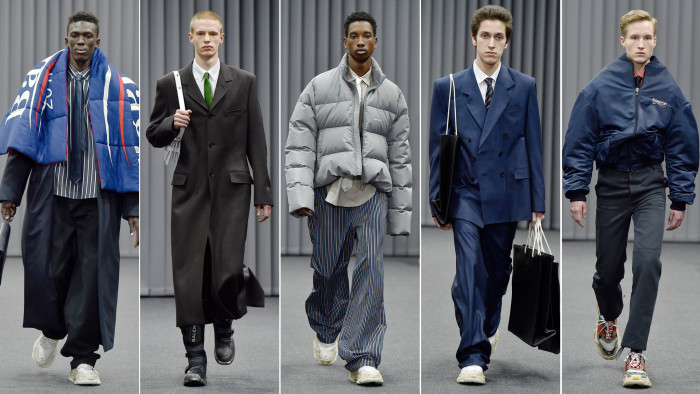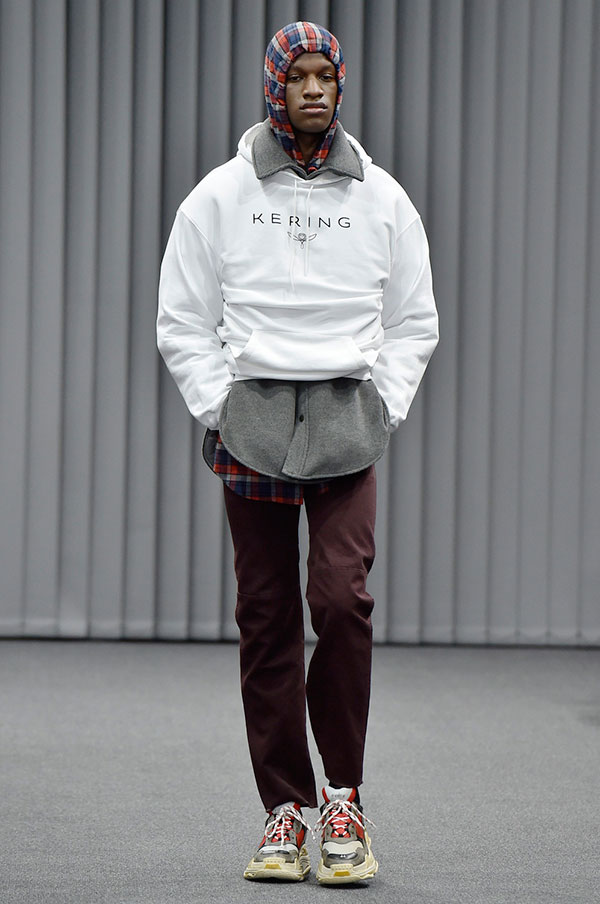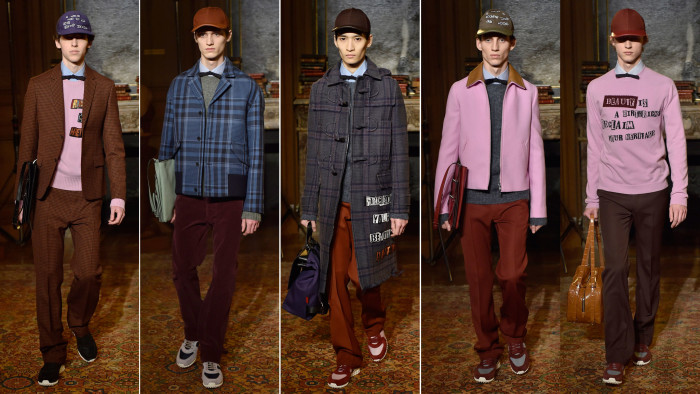Balenciaga, Valentino AW17 show report: Paris menswear

Simply sign up to the Life & Arts myFT Digest -- delivered directly to your inbox.
“It’s a guy who goes into his office on a Sunday,” said Demna Gvasalia, creative director of Balenciaga. On the first day of the Paris AW17 menswear shows, he’d just shown a collection that, among other things, mixed business suits with sneakers. This isn’t the blurred lines of casual tailoring that dominated Milan. These suits were everything that young men are meant to hate: double-breasted formal tailoring, outfits worn with business shirt and tie. From these corporate garments, he made fashion.
What a riot. Two seasons in, Gvasalia’s menswear take on Balenciaga can encompass such suits, plaid shirts, souped up technical outerwear, and sweatshirts that played with the campaign logo of Bernie Sanders and that of Balenciaga’s parent company Kering. The fake Bernie Sanders logo read “Balenciaga 2017”, over waving lines of white and red. The Kering logo was printed large on a white hoodie — an audacious move, with most brands pretending they don’t belong to a conglomerate. I was sat opposite Kering CEO François-Henri Pinault. As the model wearing it walked by, Pinault’s mouth was closed, but it raised slightly into a smile. He looked like a parent not sure if he should laugh at his kid’s joke. He should.
Gvasalia said the collection was about corporations, particularly because Balenciaga had just moved next door to the Kering headquarters in Paris. The buildings share a plaza and parking lot, and Gvasalia said he looks at corporate men in their suits everyday. “My work is always about reflecting the reality around us,” he said. “That’s just honest. It’s what’s happening.”
It turns out that Balenciaga shares a similar approach to Kering stablemate Gucci: evolve one style, avoid sudden seasonal change. This collection related to his menswear debut last summer in its strong shoulders. It also spoke to his womenswear collections in its ramped up technical outwear, like a nylon sailing zip-up in black with red trim, or an overly stuffed padded jacket in silver grey. The tactic builds a solid and repeating story, rather than the false assumption that a customer wants skittish trend flits.

The play with logos was irreverent and funny. The cut of the garments was serious. Zip-up bombers — a seemingly never-dying trend — were given yet another lease of life by fitting them tight at the waist before cutting a generous wide shoulder, pushing the silhouette upwards. There was also a neat low-waist cut of trouser. Backstage, stylist Lotta Volkova told me the models had said the cut was comfortable to wear, hanging on at the hips. Meanwhile, a crowd of well-wishers amassed around Gvasalia. “Demna for president!” called out an American editor. Amen to that.

Words on clothing can be disruptive things, like an ad campaign slapped on a beautiful building. At Pierpaolo Piccioli’s first solo men’s show at Valentino since his former creative partner Maria Grazia Chiuri quit for Christian Dior, faux punk cut-up lettering was slapped on garments to make emotive statements. One read “It seemed to be the end until the next beginning”. Why dwell on the past? “Reclaim your heritage. Beauty is a birthright” said another. Really? The last thing that big-spending luxury customers need to worry about is their birthright.
It was a shame, because the clothes beneath were often very lovely, and pointed in a new direction of clarity for Valentino. Tailoring had that neat form and flare that hints at the seventies, consolidating the message seen at Prada, as did a pair of cords. Blousons were in a wide plaid. A duffel looked neat in mint green, a zip-up sweet in soft pink. The phrases kept appearing. The only answer was to put them in a blind spot. They were sentiments better felt than said.
Photographs: Catwalking
Comments